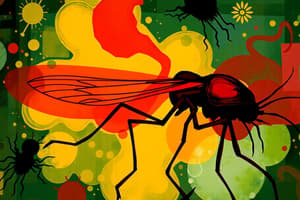Podcast
Questions and Answers
What is the name of the protist causing malaria?
What is the name of the protist causing malaria?
- Diatoms
- Plasmodium (correct)
- Dinoflagellates
- Amoeba
In which large group does Plasmodium belong?
In which large group does Plasmodium belong?
- Chrysophyta
- Apicomplexa (correct)
- Pyrrhophyta
- Rhizopoda
What is the primary food source at the base of the freshwater food chain?
What is the primary food source at the base of the freshwater food chain?
- Plasmodium
- Dinoflagellates
- Amoeba
- Diatoms (correct)
Which protist releases a large amount of energy into planktonic food webs?
Which protist releases a large amount of energy into planktonic food webs?
Which protist helps white blood cells fight disease?
Which protist helps white blood cells fight disease?
Which protist is motile and free-living?
Which protist is motile and free-living?
What is an example of endosymbiosis in animals mentioned in the text?
What is an example of endosymbiosis in animals mentioned in the text?
In bioaccumulation, what accumulates inside living organisms?
In bioaccumulation, what accumulates inside living organisms?
What is biomagnification primarily associated with?
What is biomagnification primarily associated with?
Which of the following best defines an endocrine disruptor?
Which of the following best defines an endocrine disruptor?
Why does Plasmodium continue to pose a great risk to human health according to the text?
Why does Plasmodium continue to pose a great risk to human health according to the text?
What is one example of Plasmodium's resilience mentioned in the text?
What is one example of Plasmodium's resilience mentioned in the text?
What is the difference between primary and secondary endosymbiosis in terms of mitochondrial and plastid evolution?
What is the difference between primary and secondary endosymbiosis in terms of mitochondrial and plastid evolution?
Which statement accurately describes the relationship between algae and the evolution of mitochondria and plastids?
Which statement accurately describes the relationship between algae and the evolution of mitochondria and plastids?
What evidence supports the theory that mitochondria were acquired before plastids in eukaryotic evolution?
What evidence supports the theory that mitochondria were acquired before plastids in eukaryotic evolution?
How has advancements in systematics impacted the classification of Protista as a kingdom?
How has advancements in systematics impacted the classification of Protista as a kingdom?
Why is it inaccurate to categorize Protista into one cohesive group based on evolutionary classification?
Why is it inaccurate to categorize Protista into one cohesive group based on evolutionary classification?
What evidence supports the claim that all eukaryotes studied so far have either mitochondria or modified versions of them?
What evidence supports the claim that all eukaryotes studied so far have either mitochondria or modified versions of them?




